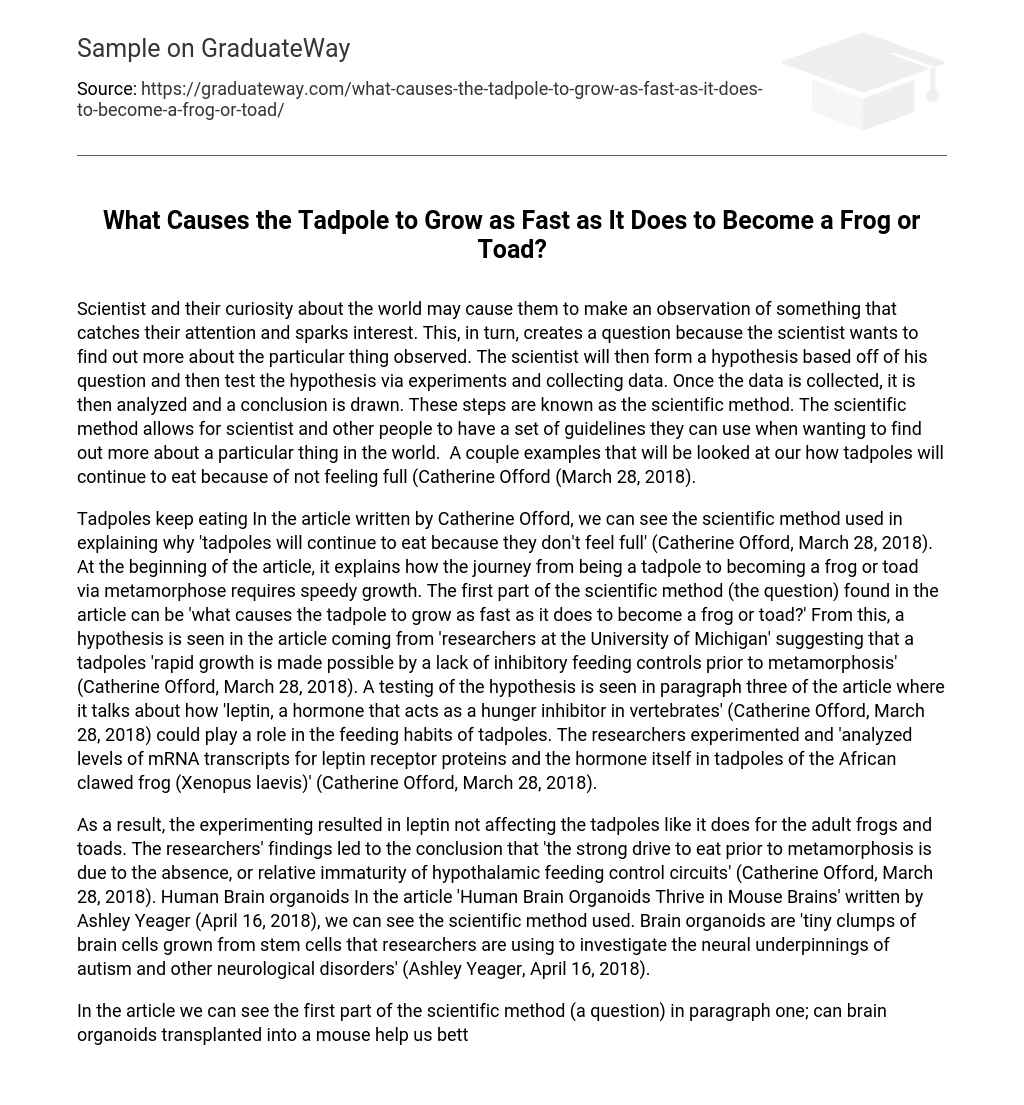Scientist and their curiosity about the world may cause them to make an observation of something that catches their attention and sparks interest. This, in turn, creates a question because the scientist wants to find out more about the particular thing observed. The scientist will then form a hypothesis based off of his question and then test the hypothesis via experiments and collecting data. Once the data is collected, it is then analyzed and a conclusion is drawn. These steps are known as the scientific method. The scientific method allows for scientist and other people to have a set of guidelines they can use when wanting to find out more about a particular thing in the world. A couple examples that will be looked at our how tadpoles will continue to eat because of not feeling full (Catherine Offord (March 28, 2018).
Tadpoles keep eating In the article written by Catherine Offord, we can see the scientific method used in explaining why ‘tadpoles will continue to eat because they don’t feel full’ (Catherine Offord, March 28, 2018). At the beginning of the article, it explains how the journey from being a tadpole to becoming a frog or toad via metamorphose requires speedy growth. The first part of the scientific method (the question) found in the article can be ‘what causes the tadpole to grow as fast as it does to become a frog or toad?’ From this, a hypothesis is seen in the article coming from ‘researchers at the University of Michigan’ suggesting that a tadpoles ‘rapid growth is made possible by a lack of inhibitory feeding controls prior to metamorphosis’ (Catherine Offord, March 28, 2018). A testing of the hypothesis is seen in paragraph three of the article where it talks about how ‘leptin, a hormone that acts as a hunger inhibitor in vertebrates’ (Catherine Offord, March 28, 2018) could play a role in the feeding habits of tadpoles. The researchers experimented and ‘analyzed levels of mRNA transcripts for leptin receptor proteins and the hormone itself in tadpoles of the African clawed frog (Xenopus laevis)’ (Catherine Offord, March 28, 2018).
As a result, the experimenting resulted in leptin not affecting the tadpoles like it does for the adult frogs and toads. The researchers’ findings led to the conclusion that ‘the strong drive to eat prior to metamorphosis is due to the absence, or relative immaturity of hypothalamic feeding control circuits’ (Catherine Offord, March 28, 2018). Human Brain organoids In the article ‘Human Brain Organoids Thrive in Mouse Brains’ written by Ashley Yeager (April 16, 2018), we can see the scientific method used. Brain organoids are ‘tiny clumps of brain cells grown from stem cells that researchers are using to investigate the neural underpinnings of autism and other neurological disorders’ (Ashley Yeager, April 16, 2018).
In the article we can see the first part of the scientific method (a question) in paragraph one; can brain organoids transplanted into a mouse help us better understand ‘Human brain development and disease’ (Ashley Yeager, April 16, 2018). We can see a hypothesis in end of paragraph one and also in paragraph two. Paragraph one end makes a hypothesis that ‘brain organoid transplantation may even one day offer a treatment option for traumatic brain injury or stroke’ (Ashley Yeager, April 16, 2018). A hypothesis from paragraph two can also be seen in the comment made in an email from a molecular biologist Jürgen Knoblich who talks about how the organoids are missing other tissues such as ‘blood vessels, immune cells and functional connections to other areas of the nervous system’ (Ashley Yeager, April 16, 2018). His hypothesis is that transplantation experiments with the organoids can ‘show that integration with those tissues is possible’ (Ashley Yeager, April 16, 2018).ReferencesCatherine Offord (March 28, 2018).





